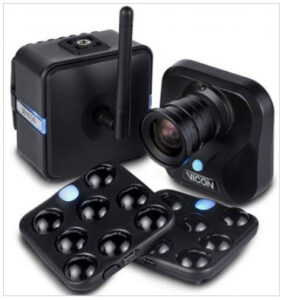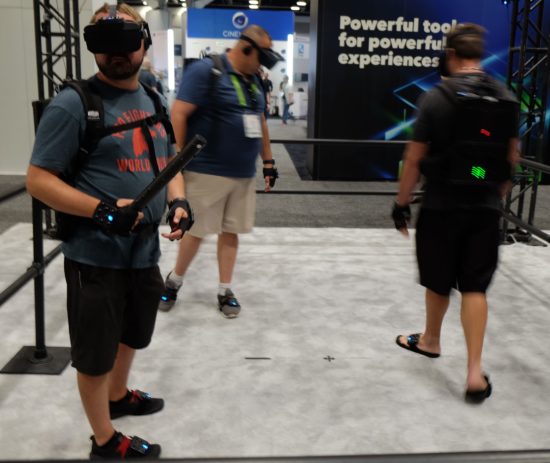The outlines of an LBVR industry are developing. Even as some are saying VR is on the way out, established companies, startups, and hardware manufacturers are building products for a new generation of location-based entertainment. The investment and customer interest promise that VR will be around for a while.
Maybe you’ve read that VR is fading. Certainly, the hype is fading, and here at Siggraph that doesn’t seem like a bad thing. The lines for VR applications are not so crazy, though they do exist. People aren’t so eager to put a headset on and look around. They’ve been able to do that with cardboard viewers for years now. People are becoming picky about content, and that’s a shift that has had to happen.
Further evidence comes just after Siggraph with the disappointing news that Google and Imax have dropped their collaboration on a movie-sized VR camera to be built on Google’s Jump platform. The project just kind of slipped away at the end of 2017, but the news finally came out from Variety and Slash Gear in the week after Siggraph. In other news, sales of Playstation VR have dropped, and, at the end of July, VR champion Richard Marks has left Sony to go to … Google. He’s at their Advanced Technology and Projects (ATAP) group. Obviously, the situation for VR is fluid. Venture Beat writer Dean Takahashi puts 2 and 2 together to assume Google is hot on the trail of games because Sony’s Phil Harrison has also joined Google.
Last December Sony reported they had sold over 2 million PS4 VR Headsets, more than all others combined. However, at E3, the company reported that even though PSVR specifically was growing, growth for the overall VR market was “below expectation.”
At Siggraph, VR applications have come out of the special halls and on to the show floor. What’s most noticeable is the quality of content. Props are big, and so is environment: VR apps are increasingly giving visitors something to hang on to, be it a sword (stick), torch (stick), machine gun (stick), you get the idea; or stationary points like walls, or handrails. Two VR experiences at Siggraph this year highlight new directions VR is taking: HP’s Mars Home VR app, and the Vicon interactive demonstration using Dreamscape content. Both are experiments in storytelling and they both make sure participants are grounded in physical reality.

HP demonstrated the culmination of its Mars Home Project with partners Nvidia, Technicolor, Fusion, Autodesk, Unreal, and Vive. The project invites people from all over the world to sign up and participate in this project that conceptualizes what the first homesteads on Mars might be like. Over 90,000 people have signed up to learn more about the program and stay in touch. The program has included several challenges such as conceptualization, modeling, and rendering. Over 1000 entrants signed up to compete in the challenges. The content created for the Mars Home Project will be returned to the 3D community as open source content for re-use and elaboration.
HP has been showcasing the Mars Home project since it has kicked off and this year, with all the challenges completed, Mars Home project team presented a 12-minute immersive video developed from the content submitted by entrants. The video was a visit to the Mars reception center where potential immigrants are shown around and invited to consider the many choices available to them as Martians. The Siggraph installation used the marvelous Positron chairs for seating. The comfy chairs which seemed to move in space and added haptic features such as rumbling, shaking, the occasional thump enhanced the experience. But most significant, I and many of the other people I talked to who took this ride, did not get sick.

The chairs were debuted at Sundance, and were used for last year’s Mummy VR experience, which was also at SXSW 2018. They are equipped with individual computer systems featuring a GTX 1070 GPU. The units can be synchronized as they were in the case of the Mars Home application to run in unison. In other situations, users might want to turn themselves around in the chair, or tilt, whatever, on their own to better explore content.
In late January, the company announced a $1.4 million seed funding deal from Lazar Ventures (founders Cathleen Ihasz and Nicole Ihasz) and Otherworld Computing to build the next-gen chair.
Get up and walk around
Vicon debuted its Origin systems at Siggraph this year. To do so, they teamed with the location-based VR (yep, new acronym: LBVR) startup Dreamscape Immersive to show a sampling of content that people might find at an arcade.
Vicon is teaming with Dreamscape Immersive, a company developing location-based VR, which was founded in 2016 by movie producer Walter Parkes (Men in Black, Minority Report), Kevin Wall, a live events producer, Caecilia Charbonnier and Sylvain Chagué (Geneva-based motion capture and development house Artanim), and investor Ronald Menzel. Along the way, the group has also picked up Stephen Spielberg as an investor—which has been good for a headline or two—but just as important IMAX, Westfield Malls, AMC Theaters (series B equity round) have also pitched in. AMD has devoted investment to content development and so has Nickelodeon. Emarati billionaire Majid Al Futtaim is onboard to take the Dreamscape locations global.

The first Dreamscape location has already been debuted for the public at the Westfield Mall in Century City with a pop-up. In addition, Majid Al Futtaim has pop-ups ready to go soon in the Middle East.
Vicon’s Origin is a technology bundle that enables customers to easily build and run a VR entertainment system. Based on Vicon’s mo-cap technology, the Origin system has specially designed hardware and software for a VR environment. The company says it has spent three years developing the system which includes:
- Viper—A compact, lightweight tracking camera specifically designed to work with active marker technology.
- Pulsar—Wearable tracking clusters that emit unique, active infrared LED patterns synchronized to ensure optimal battery life, designed to easily attach to a participant’s body, limbs, and head-mounted displays.
- Beacon—Creates a synchronized wireless network connecting to Pulsar clusters (or other devices), allowing them to communicate with Viper cameras and provide seamless connectivity.
- Evoke—A highly automated software platform featuring unbreakable tracking and auto-healing between sessions; a fully featured API, seamless game engine integration and the ability to run Evoke entirely in the background result in a flawless capture experience that anyone can operate.
At Siggraph, Vicon’s director of sale and marketing Jeff Ovadya told us the system can be set up quickly and run by anyone. The specially designed cameras, sensors, and trackers are rugged and the software and equipment is all plug and play, turn on and go. He pointed out that these installations are being designed to be more like arcade equipment rather than high-tech gear that may have involved calibration routines. Set up for the day is fast, what calibration is needed is as automatic as possible.
The origin system enables multiple participants wearing the Pulsar clusters and VR headsets to interact and to see their animated avatars, and those of the other participants. Clusters can also be attached to tools and props, so players can find them, share them, etc.
The playspace is bounded by padded rails and in the world, those rails are seen as walls or other features that can be grabbed by participants. With the use of props and barriers, the participants are not separated from the physical world. Again, participants said the connection with the real world via objects and walls meant the difference between get VR sickness or not. The people I talked to said they could spend much more time in the environment than the short 10-minute demo they actually got.

For now, location-based applications seem like a logical venue for VR experiences. And likewise, VR chairs seem a comfortable alternative to blind wandering for some apps, and especially makes sense for the evolving VR movies.
We’re already seeing the arrival of the first arcade applications. In addition to the Dreamscape sites, which are coming this year, the 2-Bit Circus founded, founded by Eric Gradman and Brent Bushnell in 2017, has a permanent space for its virtual reality arcade in downtown Los Angeles and seems to be headed for a Fall 2018 opening. The company has kept going by creating spectacles, high-end party happenings, etc. for the Hollywood scene. But, their ambition is to build a franchise of locations that can entertain families by day and get down and clubby at night. In some ways, it’s an elaboration of the Bushnell family love for electronic fun that included the Chucky Cheese pizza parlors that so captivated families in the 70s. Bushnell’s partner and 2-Bit Circus’ CTO Eric Gradman has put time in game development, content production, programming, and performance.
Another pioneer on the scene is the Void, co-founded CEO Ken Bretschneider, FX artist and magician Curtis Hickman, and interactive media designer James M. Jensen. The group originally planned to build a VR experience in Utah, but it has expanded to a multi-site venture with attractions based on movies including their first Ghost Busters: Dimension, which has run at Madame Tussaud’s at Times Square in New York. They’ve built an attraction based on the Star Wars franchise, Star Wars: Secrets of the Empire, which has had runs at the Disney Springs and Downtown Disney and also in London at a Westfield mall. The group has gotten funding from Disney and Epic Games.
So no, VR is not really fading, it’s finding itself and splintering into different mediums, which is a logical step on the way to marketability and maturity. The investment that has already happened and the work being done by small companies like The Void, 2-Bit Circus, Dreamscape and large companies such as Disney, Epic, Westfield Mall, Imax, AMC, etc. guarantees a solid generation of VR applications, content, and equipment. That means billions of dollars will be spent and made for companies, even if the world eventually decides it doesn’t like VR any more than it likes stereographic movies.
What do we think?
There’s a lot going on in VR even though people are quick to call it dead. Part of this is due to the gamer tribes. If they can play Unreal in it; they don’t care. This is a loud bunch with influence in the gaming and graphics industry but cursed with a myopic field of view.
Clearly, VR does not adapt itself to typical triple-A game playing, which is what has lead many to declare VR dead. However, the content being devised for arcades includes learning and exploration. It is developing its conventions from developing genres such as interactive plays and escape rooms.
For those in the game industry sick to death of the standard game genres, this avenue of development is also a promising new direction for games as well. The game industry is blossoming beyond its hard candy core, as evidenced by the crazy success of Fortnite and anyone-can-play free-for-alls on mobile. XR, which is short for AR/VR/MR, is another promising option.
Finally, an important subtext of this story is the role motion caption is playing in the evolution of immersive gaming. Vicon is the only public mocap company and one of the most successful. In its last annual report for the fiscal year ending in September 2018, the company reported revenues of $26.65 million. It’s a living, but it’s not a great living for a venerable company that was founded as a leveraged buyout in 1984. The company has never had huge growth, and in the recent past, revenues have gone down as it has been paring back to concentrate on potential growth areas.
Motion capture is essential in content creation, but it’s a small specialized market. The interest in interactive VR and LBVR is giving new life to companies that have to work really hard to justify their R&D budgets.





